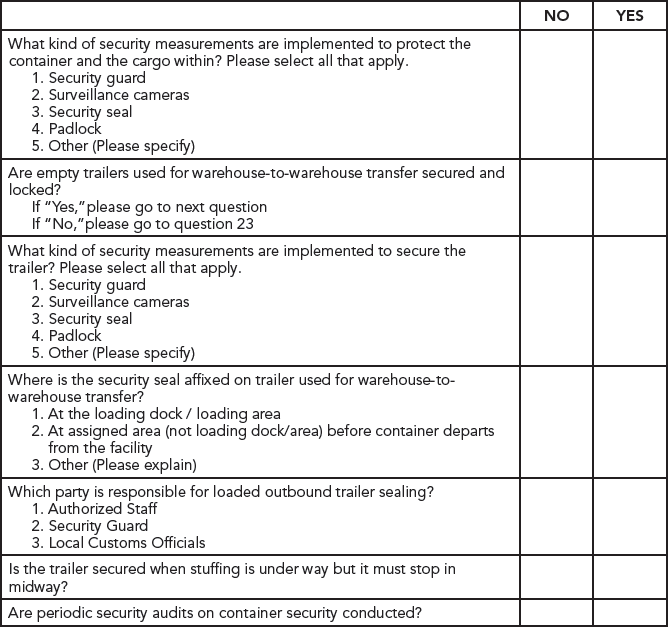12
Bureau of Customs and Border Protection: Compliance and Security Expectations: Post 9/11
The focus of this chapter is to provide a detailed overview of just what the Bureau of Customs and Border Protection (CBP) expects from the importing community in securing the supply chain since the terrorist attacks of September 11, 2001, through to the third decade of the new millennium.
PRE 9/11
In this book, we have covered the subject of customs enforcement before and post 9/11. The focus of then-called U.S. Customs before 9/11 was revenue, collection, and compliance. Programs like informed compliance and focused assessment were in effect from 1993 to 2002.
Once 9/11 occurred, indicative of Customs’ new name, “Border Protection,” its focus changed to protection of our borders.
Securing the inbound supply chain became the number one priority of the CBP. New buzzwords became relevant, like Customs Trade Partnership Against Terrorism (C-TPAT), Container Security Initiative (CSI), and 24-Hour Manifest, all of which have been discussed in preceding chapters.
Customs has a very specific agenda post 9/11, which is making sure that the inbound supply chains are secure and compliant. Inbound documentation and compliance issues like classification, valuation, and origin are all still critical, but the focus is on the security of the “supply chain.” Every customs seminar we have taken since 9/11 (well over 25) has broached this subject with this articulation.
Also keep in mind that CBP was moved from reporting to the Treasury to the new Office of Homeland Security (Figure 12-1).
CBP advises on the following:
1.Most importers, along with certain exporters should consider joining C-TPAT. It will expedite their clearances, and in the event of a new terrorist attack, when the borders reopen, there will be clear advantages to the importer that is a member of C-TPAT.
2.Larger importers (over $10 million in value), and eventually all, should consider the new Customs Program Internal Self-Assessment (ISA). This program affords the importer to be classified as a “low risk” to customs.
FIGURE 12-1. U.S. Customs and Border Protection (CBP) is part of the Office of Homeland Security and a cabinet position aligned with the president they are serving.
This provides an advantage to the importer to reduce the opportunity for a “focused assessment” audit from the CBP.
Specifically, using a process of completing applications and passing an audit proves the importer has developed an internal set of operating procedures with a clear and precise paper and audit trail in place.
An importer gains access to the ISA program by validating that it can internally make sure it is following customs regulations.
3.Working the CBP “Account Management Program” from a question and answer perspective (see following section).
CBP ACCOUNT MANAGEMENT PROGRAM
The Account Management Program began in 1997 as a method to increase compliance while reducing costs and inefficiencies for CBP and the trade. The mission of account management is to use account-based (rather than transaction-based) methods consistent with risk management principles to develop and maintain the highest levels of trade compliance and to enforce, regulate, and administer U.S. trade laws, while fostering the flow of lawful international trade.
By viewing a company and its trade performance in the aggregate, account management is intended to raise compliance, facilitate the flow of legitimate trade, and increase efficiencies. It does so, in part, by providing a National Account Manager to significant importers and broker accounts.
An account is an importer or a customhouse broker. The account may be defined by a single Importer of Record number, by a group of Importer of Record numbers, or by one or more filer codes. All participants in the Importer Self-Assessment (ISA) program are assigned to an account manager. This is a significant incentive to join the ISA program. The account manager performs oversight of these accounts for the ISA program.
The account manager serves as a primary point of contact to the account for trade-related issues and also serves as a primary point of contact for the account within CBP to establish and support smooth-working relationships among the many CBP disciplines that interact with the account. The account manager also provides guidance and assistance to the account and collaborates with other CBP disciplines to create and implement comprehensive strategies to manage and segment risk, solve problems, and increase efficiencies.
As part of CBP’s trade transformation efforts, each account manager is now a core member of one of the ten Centers of Excellence and Expertise. The ten centers are
![]() Agriculture & Prepared Products
Agriculture & Prepared Products
![]() Apparel, Footwear & Textiles
Apparel, Footwear & Textiles
![]() Automotive & Aerospace
Automotive & Aerospace
![]() Base Metals
Base Metals
![]() Consumer Products & Mass Merchandising
Consumer Products & Mass Merchandising
![]() Electronics
Electronics
![]() Industrial & Manufacturing Materials
Industrial & Manufacturing Materials
![]() Machinery
Machinery
![]() Petroleum, Natural Gas & Minerals
Petroleum, Natural Gas & Minerals
![]() Pharmaceuticals, Health & Chemicals
Pharmaceuticals, Health & Chemicals
FOREIGN VENDOR SECURITY ASSESSMENT

CONTAINER AND DELIVERY TRUCK SECURITY

PHYSICAL ACCESS CONTROLS

PHYSICAL SECURITY

PROCEDURAL SECURITY

INFORMATION AND INFORMATION TECHNOLOGY SECURITY

PERSONNEL SECURITY

SECURITY TRAINING AND THREAT AWARENESS

CONCLUDING REMARKS
CBP is the major player in managing the security and compliance controls on inbound freight to the United States. This chapter was structured to emphasize their role and provide valuable insight into their mind-set.
Companies and their executives who operate in purchasing and the inbound supply chain will best be served in learning how to navigate CBP regulations while keeping their operational activities up and running cost effectively and at the same time compliantly.






